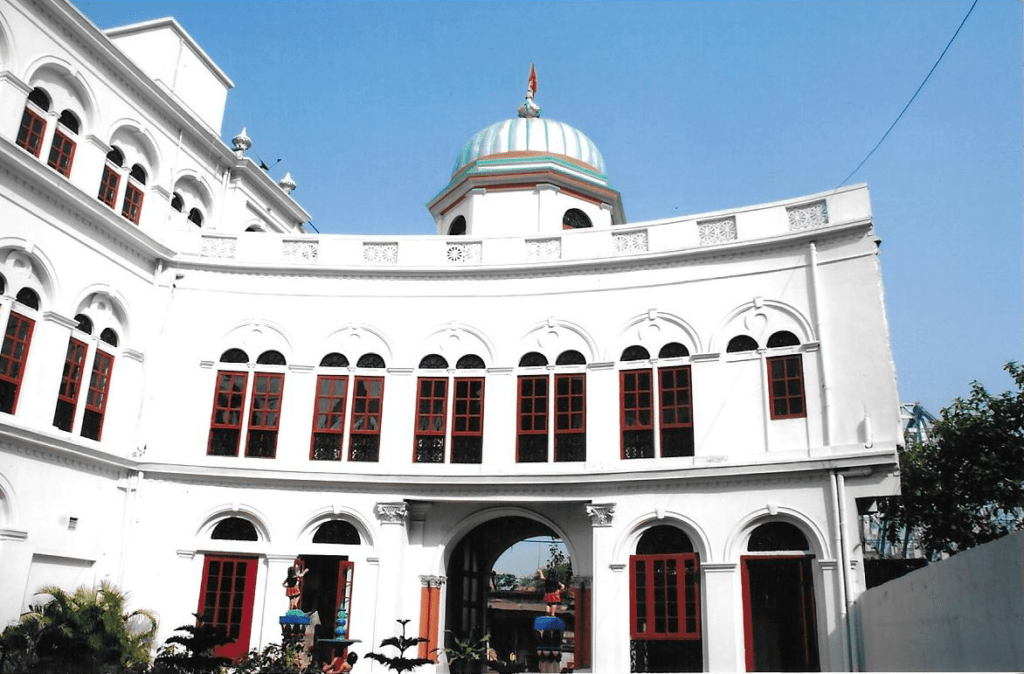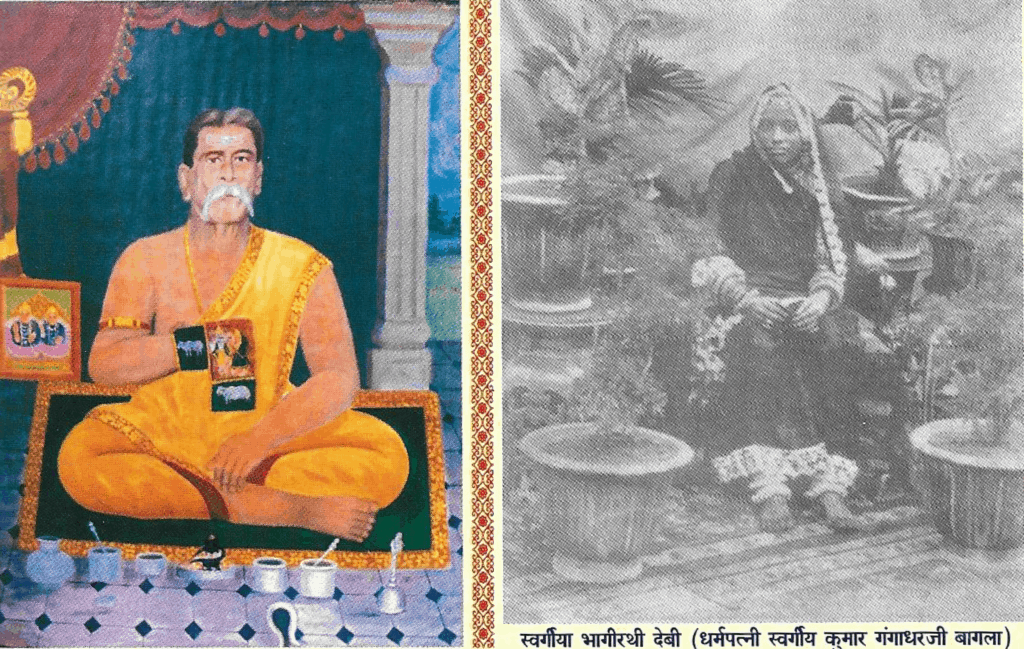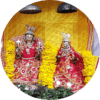Satya means “truth” and Narayana means, “the highest being” so Satyanarayan means “the highest being who is an embodiment of Truth”. It’s well established in all the Scriptures (Shastras) and Vedas, that Shree Shree Satyanarayan Bhagwan is the supreme God representing all other Divinities including the Creator (Bramha), the Sustainer (Vishnu) and the Destroyer (Shiva).
Shree Shree Satyanarayan Bhagwaan has been the Ishta Deva, or "cherished divinity" from iṣṭa "desired, liked, cherished, preferred" and devatā "godhead, divinity, tutelary deity" or deva "deity" of Bagla Community since the very beginning.
1849
1908
Raja Raibahadur Shewbuxjee Bagla
Shew Buxjee Bagla was born on 28th October 1849 A.D. to Seth Ramdayaljee, an ardent devotee of Satyanarayan God. Ramdayaljee and his father, Ramdaasjee were from Churu, Rajasthan.
In 1847 A.D, Ramdayaljee came to Calcutta, to work, and started living in Cotton Street, then known as Tulapatti as Tula (cotton) trade was carried on in that area. That time also he used to duly worship an image Shree Shree Satyanarayanjee and Shree Laxmijee and other Deities, which is still in the Calcutta Temple sanctum. In the same year, he established The Deities at his own house at Calcutta. Seth Ramdayaljee died on Marghsish Sukla Purnima SY 1817, leaving his son at an only 12 years of age.
Read More
In 1871 A.D. Shew Buxjee Bagla started business in Rangoon, Tantmou and Moulmein Burma. He contructed big Saw mills at Moulmein in the name of ‘Ramdayal Shewbux’ & ‘ShewBux Saw Mills’. Besides hundreds of humans, specially trained elephants also worked in the factory, to lift heavy timber logs from adjacent Irawaddy River, to be sawn into timber of various sizes. The same was also shipped to India and sold at 67/20 Strand Road, Calcutta.

In 1875 A.D. Shewbuxjee constructed a huge Temple of marble for Shree Satyanaryanjee and Shree Laxmijee and other Deities in Moulmein, Burma. A lot of properties including two gigantic buildings of Rangoon, a garden at Moulmein were donated to the temple so that the rental income from the same can be used for the welfare of the Temple.
On 10th May 1883, he bought a property at 51 Cotton Street, Calcutta and made into a Temple House with domes on the roof and Auditorium on the first floor. The Centenary of the same Temple was celebrated with much pomp and splendor on 10th May 1983 AD. Thereafter on 31st August 1889, he purchased acres of lands and properties in Howrah and Salkhiya and donated all of it to the Trust. In Howrah, he also constructed a house where he moved in with his family to look after the work of the Trust.

Shewbuxjee then consecrated another Temple, dedicated to Shree Satyanarayanjee, Shree Laxmijee and other Deities, next to the Lord Vishwanathjee Temple in Varanasi and on 24th January 1887, at Saraswati Pathak (which now has been shifted to D1/8 Lahori Tola due to the Kashi Vishwanath Temple Corridor project by the Government).
He also drafted a written Deed of Dedication outlining the necessary recital directions, list of ornaments of the Deities, and all other festivities to be observed by the Trustees and Shebayat at both the Temples. This deed was executed on 11th January 1888 and is still referred today. He started the Sawari (Procession) of Shree Shree Satyanaryanjee and other Deities on palanquin, which began with a day function and soon became a four-day affair ending at Holi.
On 21st August, 1888, Shewbuxjee’s prayers were answered and a son was born to him and his wife, Mani Devi. They named their son Gangadhar. Unfortunately, mother Mani Devi expired after only eight months and to look after the new born, Shewbuxjee remarried to Mohari Devi and was blessed with a daughter named Fulbai in 1894 AD.
From his childhood, Shewbuxjee worked hard to rise high and make his life glorious. He got immense knowledge on religion and business by his father since the beginning. His respect for Cows and Brahmins knew no bounds. He established Pinjrapole Gaushala (Cow Care Centre) in Churu, Rajasthan and in Calcutta. Donation of blankets in winters amongst the poor and funds for marriages of poor Brahmins were few of the many charitable activities carried on by Shewbuxjee. He also gifted lands and Rs. 60,000 to the Bengal Veterinary Hospital at that time.
In appreciation of his services to humanity, on 3rd June, 1893 AD, the title of ‘Rai Bahadur’ was conferred on him by Lord Elgin, on behalf of the Government of India. Again on 22nd June, 1897 AD, he was honored with the title of ‘Raja’ and awarded a ‘diamond crown’ by the Queen Victoria. His wife Mohari Devi was called ‘Rani’ and son, Gangadhar was called ‘Kumar’. The jewel crown is now being adorned by Lord Satyanarayanjee at the Calcutta Temple.
Inspite of having no English education, Shewbuxjee was appointed at various posts in the government, including that of the Commissioner of Corporation, Port Commissioner and Honorary Magistrate. In 1893 AD, he became the Sheriff of Calcutta High Court.
On 8th October, 1908 AD, on the pious day of Vijay Dashmi, Raja Raibahadur Shebuxjee Bagla left for heavenly abode after suffering a paralysis attack. His body was cremated in the scared land of the Deities in Salkhiya, on the banks of the Holy Ganges. As appointed by him in the Deed, his wife, Rani Mohari Devi and son, Kumar Gangadhar Bagla become the Trustees and Shebayets. Shortly after two years, on 5th June 1910 AD, Rani Mohari Devi also left for her heavenly abode and she was also cremated in the same way in Salkhiya.
1888
1964
Kumar Gangadharji Bagla
Gangadharji was born on 21st August 1888 to Shewbuxjee and Mani Devi. He was only 20 years of age when his father, Raja Shewbuxjee, left for his heavenly abode. At that time Gangadharji was the sole trustee and responsible for carrying out the Seva and Puja.
He constructed magnificent temples on the cremation site of his parents consecrating Shiv Pariwar at the Samadhi site of Rajaji and Sitala Mata at the site of Rani Mohari Devi.
Read More
Gangadharji married Bhagirathi Devi on 18th November 1900 and after sixteen years of married life, was blessed with a son, who was named Satyanarayan Bagla.
During this period due to the rapid changes in the world starting from transport and lighting to roads and buildings, the grandeur and popularity of the temples in Calcutta and Varanasi reached a new height. Kumar also changed the procession or Sawari of Satyanarayan Bahgwaanjee in Calcutta – from palanquin, God came on chariot driven by horses, soon replaced by chariot on Minerva Car and finally on Rolls Royce, which is still the Sawari or transport of God today.
On 2nd and 3rd June 1934 AD, Kumar Gangadharji celebrated the semi Centenary of the Calcutta Temple with great pomp and splendor and a grand procession through the streets of Calcutta. Alongside Hindu God and Goddesses, it also included Sikh devotees carrying their own flags. Throughout the street, people worshipped Deities, showered flowers and performed Aarti and danced with joy.

In 1900 AD, with his son, Satyanarayan Bagla, Kumar Gangadharji started a business of trading used cars under the name of Bagla Motors. They evn purchase ex army jeeps and remodeled them, calling as Bagla Jeep which gained immense popularity. Like father, he also donated a property in Churu to the Pinjrapole society.
During the short tenure of 56 years, Kumar Gangadarji perfomed his duties whole heartedly and devoted most of his time in the services of Shree Shree Iswar Satyanarayanjee and other Deities. On 20th September 1964, Kumar breathed his last and was also cremated at Salkhiya, Howrah. His wife, Bhagirathi Bagla expired on 1st February 1969 and her last rites were also perfomed at Salkhiya, just beside the cremation site of her husband.
1916
1992
Satyanarayanji Bagla
Satyanarayanji Bagla was born on 31st October 1916 to Kumar Gangadharji and Smt. Bhagirathi Bagla. Since childhood, Satyanarayanji was a devotee of God and Bhagwat Gitaji. His parents always insited on good education for him and because of their efforts, he passed the Bar in 1937 with Sir Aushutosh Mukherjee Law Prize, from Calcutta Vishwavidhyalaya. In 1940, he also cleared the Solicitor Examination with flying colours. He was awarded the Belchambva Gold Medal besides other various medals and prize, and immediately Satyanaryanji started practicing Law to help the weaker. On 25th September, 1941, he was blessed with a son named Lalit Bagla.
Read More
After his father passed away, Satyanarayanji took over the responsibilities as a Trustee in 1964. He and his wife, Parbati Devi, constructed beautiful temples over the cremation site of their parents and soon installed huge idols of Lord Shree Gangadhar Mahadeo and Shree Bhagirathi Gangaji in these temples.
Together with the help of his wife, Satyanarayanji efficiently carried on the duties and crossed each hurdle faced as a Trustee with ease. They both gave away a major part of their wealth to the Deities and for other charitable purposes. In 1977, with much persuasion and hard work, he managed to change the main door of the Temple giving it a royal look. He purchases a two floor building opposite the Temple in Varanasi and donated the same to the Trust to be used as a free Dharamshala. Out of their contribution, a free homeopathic dispensary was started at the Calcutta Temple. In 1983, for the protection of Cows and economically weaker sections of the society, he established Shree Shree Satyanaryanjee Lakshmiji Charitable Trust.

After miraculously escaping a near death situation, Satyanarayanji celebrated the Centenary of Calcutta and Varanasi Temple with great pomp and splendor. The festivities in Calcutta started on 1st June 1984 with the worshipping of Gods, Hawan and fireworks and lasted till 4th June 1984, ending with a larger than life procession of Gods and Goddesses followed with music and dance. Varanasi witness similar celebrations on 3rd February 1987, commemorating the hundred years of the Temple.
Satyanarayanji was always focused on serving the God and nothing else mattered to him. On 13th October, 1992 taking the name of Lord Shree Satyanarayanjee, he breathed his last, saying he is going back to where he came from. Like the family tradition, he was also cremated at the holy banks of Ganga in Salkhiya, Howrah, where a temple of God Shree Harihar and Maa Annapoorna was built. His wife, Parbati Devi, spent her remaining years in Varanasi and in 2002 left for her heavenly abode. She was also cremated at the same ground in Salkhiya, Howrah, where her son, Lalit Bagla, constructed a similar temple in her remembrance.



